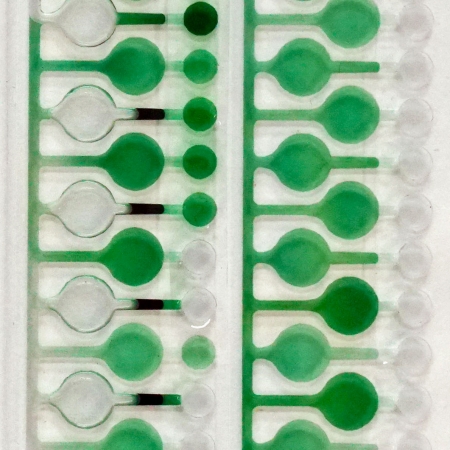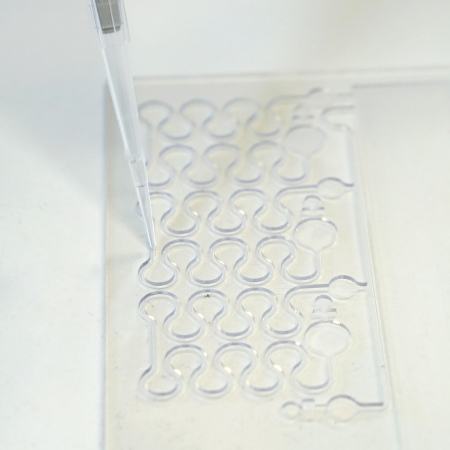Guided acoustic waves in sensors and actuators
Since its foundation, ISAT has been conducting research in the field of non-invasive ultrasonic sensor technology with a focus on “guided acoustic waves”. Guided acoustic waves are ultrasonic waves that propagate on the surface of a substrate. The most commonly used types are Rayleigh and Lamb waves. Lamb waves are plate oscillations and occur when the wavelength of the excited sound wave is greater than or equal to the plate thickness. They therefore exhibit particle deflections on both sides of a substrate, i.e. the wave passes through the entire material. This property of lamb waves allows their excitation on the back of a material, while the actual sensory interaction can take place on the front. Rayleigh waves are when the wavelength of the excited sound wave is smaller than the thickness of the substrate. Particle deflections caused by Rayleigh waves are thus only generated on the side of the substrate on which the wave was excited. ISAT uses Lamb waves mainly for the development of non-invasive sensors and actuators due to the above mentioned properties. Rayleigh waves are used in the institute for material characterization or crack detection.
To generate guided acoustic waves at ISAT, comb-like structured metal electrode structures on piezo materials are primarily used. By the number of finger pairs and the finger distance of the combs, the most different frequency characteristics can be achieved, whereby an adaptation of the excitation is possible depending upon material type and material thickness. As carrier materials for guided acoustic waves the most different materials can function, e.g. glass, metals, ceramics or different plastics. It is also possible to excite guided acoustic waves contactlessly via optical methods (laser excitation) or magnetostrictively.
In both Lamb waves and Rayleigh waves, the vibrations occurring on the surface of the material are so small that they cannot be felt and no damage to the material occurs.
Guided acoustic waves can be used in a variety of sensor applications. They can also be used for actuator development. The basis for the use of guided acoustic waves in sensors and actuators is above all their specific interaction properties with liquids.
Short info Rayleighwaves
- wavelength < thickness of the substrate
- propagation only on one side of the substrate
- penetration depth into substrate max. 1 wavelength
- non-disperive (constant propagation velocity)
Rayleighwave

Short info Lambwaves
- wavelength > thickness of the substrate
- propagation on both sides of the substrate
- different vibration modes
- dispersive (change in propagation velocity as a function of frequency)
Lamb waves with symmetrical and antisymmetrical propagation modes
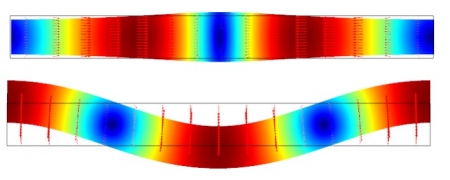
Interaction properties of guided waves with liquids
1. Mode conversion
If the speed of propagation of the guided acoustic waves on the substrate is greater than the speed of sound in the surrounding medium (e.g. liquid), the guided wave decouples as a compression wave into the surrounding medium. This effect is called mode conversion and can be understood as an acoustic analog to optical refraction. If the properties of the surrounding medium change, this also influences the decoupling angle and consequently the length of the sound path, which results in a precisely measurable change of the sound propagation time. At the same time, the wave component remaining on the substrate and not decoupling is attenuated, which can also be detected as a change in amplitude.
Radiation of a guided wave via mode conversion into the adjacent liquid.

Use of mode conversion in sensor technology
The mode conversion effect is used, among other things, for the detection of deposits in liquid-filled systems such as pipes, for the measurement of liquid properties or for the measurement of flows and detection of air bubbles in liquids. ISAT also uses the damping effect of decoupling the wave into the surrounding medium to generate touch-sensitive surfaces. Here the human tissue behaves on contact with a substrate on which the acoustic waves propagate similarly to a liquid, i.e. the wave e.g. decouples the finger and a damped wave remains on the substrate.
Touch-sensitive surface with touch effect by decoupling the lamb wave into human tissue.
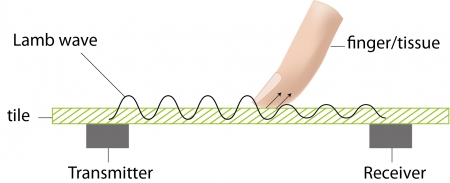
Use of mode conversion in actuators
The mode conversion effect can also be used in the field of actuators. In actuator applications, however, significantly higher excitation voltages must be used in comparison to sensory applications in order to achieve the desired effect. The impulse transfer to the liquid that occurs during mode conversion generates what is known as acoustic streaming in these flows. These acoustic flows can be used to move or mix liquids. Typical applications in ISAT are drop removal or the transport of liquids in microfluidic channels.
Droplet movement by decoupling (mode conversion) of the lamellar wave into liquid droplets.

2. Evanescent wave field
If the speed of sound in a liquid is greater than the speed of sound of the guided acoustic waves on the substrate, the wave cannot be decoupled into the liquid in accordance with the law of refraction. The wave remains bound to the substrate. These waves that do not decouple are called Scholte waves. An important property of these Scholte waves is their evanescent field (“energy field”), which extends from the solid into the adjacent liquid.
Acoustically induced sreaming/vortices through evanescent wave field

Evanescent wave field in actuators
The evanescent field of Scholte waves generates eddy currents at the solid/liquid interface with sufficient excitation voltage. The dimension of the vortices corresponds to the order of magnitude of the wavelength of the acoustic wave, so that it can be controlled how far the evanescent field reaches into the liquid. The advantage of using Scholte waves is that processes can be specifically influenced at the interface between solid and liquid. ISAT uses this property in the field of actuator technology to influence electrochemical reactions, e.g. to accelerate the charging of accumulators.
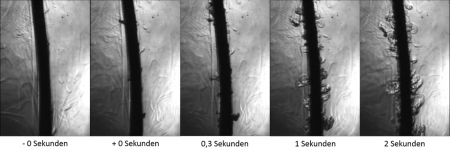
Schlieren-optical recording of vortex flows at the interface of a solid and a liquid. The flows are generated in a viscous boundary layer close to the solid surface.
Evanescent wave field in sensor technology
In the field of sensor technology, ISAT uses Scholte waves for level measurement, among other things.
Use of guided waves for material characterization
Guided waves, however, can also be used sensorically without the substrate having to be in contact with liquid. Guided waves are particularly suitable for material characterization. ISAT has developed a non-contact laser-based method for the excitation and detection of guided acoustic waves. A short laser pulse focused on the substrate surface leads to a locally sharp thermal expansion and contraction of the material, which allows broadband excitation of acoustic waves. The laser-based method can be used for detection and characterization of layer systems, stresses or crack detection. You can find out more about non-contact generation and detection of guided acoustic waves here.
ISAT is active in the design and simulation of optical components and systems, in particular microoptics, integrated optics and fiber optics. The CAD tools and the simulation software ZEMAX and COMSOL are used for the design, modelling and simulation of optical components. In addition, ISAT has a clean room tent with coating plant, spincoater and maskaligner for the complete photolithography process chain. This allows micro-optical components such as waveguides or diffraction gratings to be manufactured directly in polymers according to customer requirements. Alternatively, optical components can be produced in a downstream step by ion exchange in glass. Such components are mechanically and thermally stable and, due to the index gradients, particularly advantageous for measurement tasks where the polarization properties of the transported light are important.
A variety of instruments and optical measurement equipment are available to the Institute for testing and characterization of samples, both from its own facilities and from external cooperation partners. Various microscopes (confocal, laser scanning, fluorescence microscope), white light interferometers, laser scanning vibrometers, thermal imaging cameras and our own measurement setups are just a few examples. ISAT also has fiber-optic measurement systems for quasi-continuous, spatially resolved measurement of temperature and/or strain changes (so-called Rayleigh sensors) and for measuring temperature, strain, vibration inclination and acceleration at several measurement points distributed over the fiber (so-called FBG sensors). These fiber-optic measuring systems enable the acquisition of measurement data over long distances (up to 50 m for the Rayleigh system, up to several km for the FBG system).
ISAT’s activities in the field of optical sensor technology include, for example, the monitoring of critical infrastructure such as bridges through fiber-optic measuring systems or the development of KI-based image processing algorithms for the manufacturing industry.
The advancing miniaturization of microtechnology has not only led to groundbreaking innovations in the field of microelectronics, another key technology has also benefited from the development of new manufacturing techniques, namely microfluidics. Similar to microelectronics, a performance with disruptive potential can be created in the field of microfluidics by combining many functional units in integrated chips. These chips are called Lab-on-a-Chip (LOC) systems or micro-Total Analysis Systems (µTAS) in the case of microfluidics because they allow complete analyses to be performed that would otherwise require a laboratory.
Microfluidic chips have similarities with electronic circuits, only that in contrast to them, no electrons but chemicals are transported in defined channel structures. The main fields of application for LOC are subunits of laboratory equipment and point of care testing systems for medical diagnostics. Examples for the first area are miniaturized gas chromatography and electrophoresis, for the second it is blood glucose meters, pregnancy tests, blood coagulation tests or tests for cardiovascular markers. In addition to accelerated analysis, the advantage of LOC is the potential of on-site diagnostics and the possibility of multiparameter determination.
The diameter of the channels of microfluidic chips is usually not less than 10 µm, since a certain sample volume is always required for the detection of an analyte, which is in the order of > 1 ml. In addition, a minimum channel size in the order of the cell diameter is required, especially for the transport of body fluids and cells circulating in them. In order to keep production costs as low as possible, microfluidic chips are usually made of plastics that can be manufactured using a wide variety of processes, e.g. milling or photolithography. At ISAT, three possible techniques are used: pressing or injection moulding, structuring using photolithography and milling. It is important to choose a material that is resistant to chemicals and ensures a good flow of the liquid. A typical chip material also used in ISAT is polycarbonate (PC). The channel structures of a microfluidic unit have a great influence on the flow behaviour, which is why chip design is of enormous importance. In ISAT, the flow behavior within the channels can be simulated using appropriate software tools, allowing the chip to be designed specifically to meet the analytical requirements. Afterwards, 3D CAD models of the channel design can be created in ISAT and the chip can be manufactured using an existing milling machine. For the mixing of the chemicals on the chip, meander-shaped mixer structures are usually used. Alternatively, mixing can also be carried out using a combination of microacoustic actuators. In order to achieve the desired wetting properties of a surface, the surface of the channels can be functionalized in a defined way. The aim is to attach functional groups to the chip material to facilitate the flow through the microfluidic chip.
To push forward technological innovations within a company, it is insufficient to count solely on experimental development. For a target-oriented development of new products and processes, computer-based simulation is an integral part for high-tech companies, since simulation has a tremendous saving potential regarding development time and costs. The ISAT offers proven expertise in the field of „simulation and testing“ and owns a wide variety of software packages for a simulation based technical design of sensors and actuators.
simulation optical splitter

simulation acoustic streaming

simulation electrical field

simulation guided acoustic waves

We conduct computer-based simulation in the following fields:
- Acoustics
- Optics
- Fluid mechanics
- Structural mechanics
- Thermodynamics
- Electronic circuits
Available software:
- COMSOL Multiphysics
- Disperse
- Zemax
- MATLAB
- LTspice
- Python
- Altium
- various development boards for electronics
Contact
ISAT – Institute of Sensor and Actuator Technology
Coburg University of Applied Sciences and Arts
Am Hofbräuhaus 1b
96450 Coburg, Germany
Phone: +49 9561 317-437





